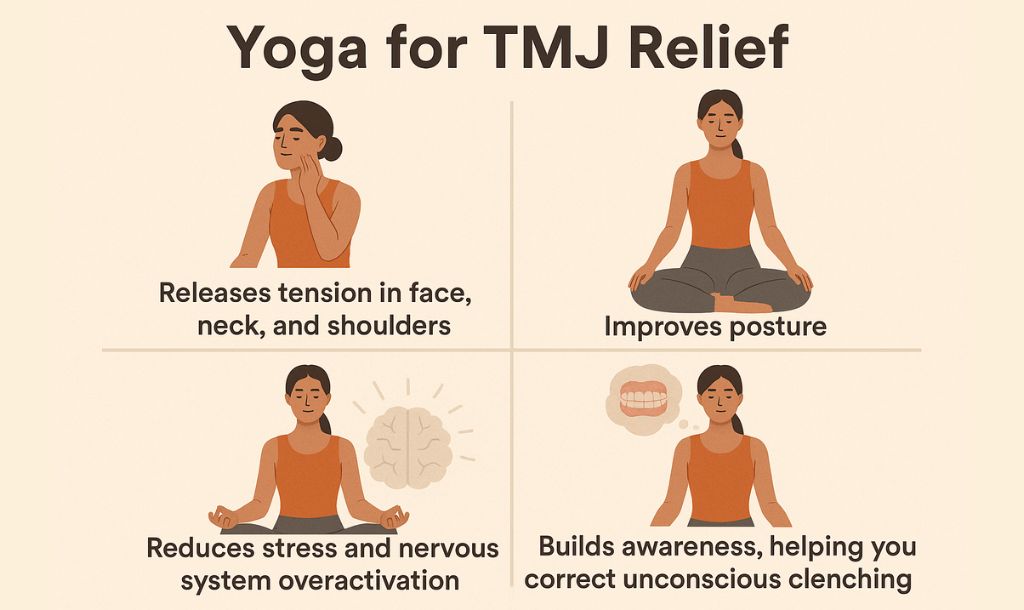What is Vriksasana (Tree Pose)?

Vriksasana, or Tree Pose, is a classic standing yoga asana that helps center and stabilize your body while standing, and strengthens the core.
Tree pose is all about rooting your feet into the mat like a tree and finding your balance on one leg. The more balanced you feel in your Vriksasana practice, the more grounded you will become within your mind, body, and soul.
Overview and Etymology
This pose is an ancient Hatha yoga posture and the name Vriksasana means Tree-like Pose in Sanskrit. The word Vṛkṣa means Tree, and Asana means Posture.
Among various postures taught by the Adiyogi (Lord Shiva) included in Gheranda Samhita, the Tree Pose is a prevalent one.
A tree is strong and grounded. It's something that grows both in an upwards and downwards direction. Many Rishi (Hindu Sages) used to show their devotion towards the supreme power by holding this one pose for hundreds and thousands of years.
Even today, you can encounter stone carvings in Mahabalipuram in which sages are standing in this stance under a tree or beside a flowing river.
Sanskrit Name: वृक्षासन Pronunciation: vrik-SHAHS-anna
Pose Type: Standing Also known as Tree Pose
Strengthens: Spine, Knees, Thigh, Ankle, and Calves
Stretches: Thorax, Pelvis, Spine, and Shoulders
Health Benefits of Vriksasana
- Improves your standing posture.
- Helps to balance your emotions.
- Improves mental concentration.
- Strengthens and lengthens the spine.
- Increases core balance and core strength.
- Helps build mental awareness and mindfulness.
- Opens the pelvic muscles and makes the legs strong.
- Stimulates Root Chakra, Eye Chakra, and Crown Chakra.
- Opens the chest, rib cage, and diaphragm, and improves breathing.
When to Avoid Performing Vriksasana
- Avoid if you’ve had a recent spinal injury or surgery.
- Avoid if you’ve had a recent hip injury or hip replacement surgery.
- Avoid if you have issues in balancing and/or inability to stand.
- Avoid if it's challenging for you to connect with breath awareness.
- Avoid if you have severe migraines, vertigo, or arthritis conditions.
How to do Vriksasana (Tree Pose)
Follow this step-by-step guide to learn how to practice Vriksasana:
Part 1 - Preparatory Poses for Vriksasana
The very first part of any yoga pose practice is a warm up, so that you can safely practice without injury. Here is a list of warm-up poses you can do before the tree pose.
1. Surya Namaskar (Sun Salutations) - This is a yoga flow with a series of 12 yoga poses. When you perform these poses for 10 to 12 rounds, you will feel a rush of blood circulating throughout your body.

As a result, this yoga flow will help you loosen tight muscles and stiff joints. This series is a must-do before you move forward.
2. Tadasana (Mountain Pose) - Tadasana is one of the most influential foundational stances for all standing poses. It is the literal embodiment of standing with intention and integrity.
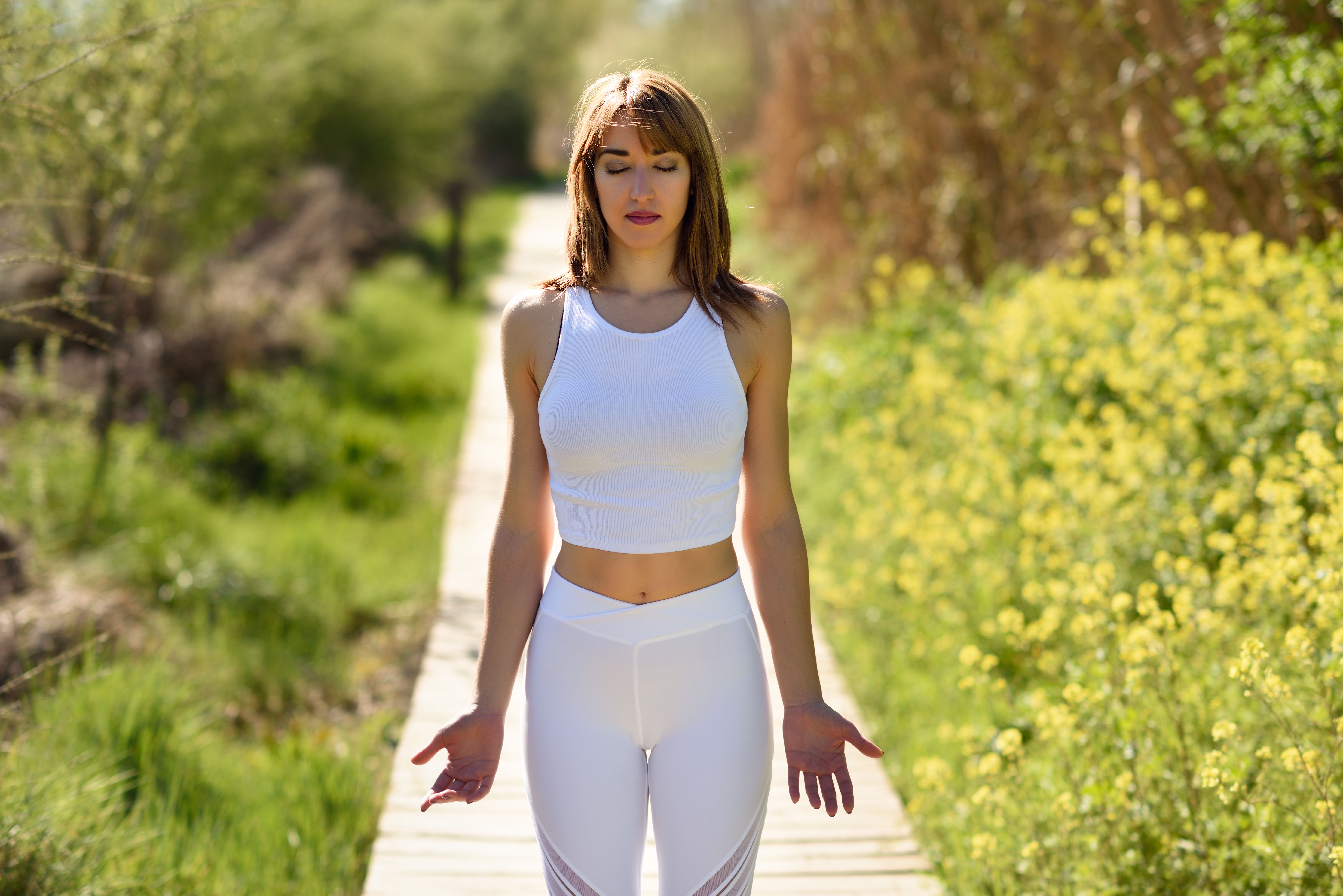
For the tree pose, it's essential to activate the muscles around your legs as well as your core, and the Mountain pose helps you stimulate these muscles instantly.
3. Dwikonasana (Standing Yoga Seal Pose) - Rolling over the upper body and bending forward with palms clasping each other, release any tension or strain in your upper back and hamstrings.
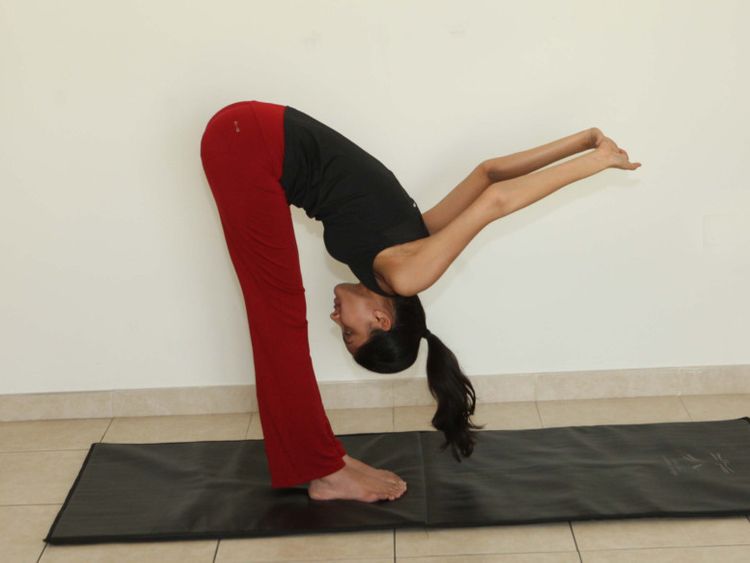
This is a beginner-friendly standing yoga pose for shoulder mobility and leg flexibility.
Part 2: Step-by-Step Instructions to Perform Vriksasana
Below are the steps to practice Vriksasana pose:
Step 1- Stand in the middle of the mat, with your weight balanced equally between your feet.
Step 2- Keep your arms relaxed at your sides, and steady your breath.
Step 3- Now, transfer your body weight to your left foot, softly bend your right knee, and pull it into your chest.
Step 4- Place the sole of your right foot on the inside of your left thigh. Keep your spine and head straight, with your gaze forward.
Step 5- Place your hands in a prayer position in front of your chest.
Step 6- Take a few deep breaths and engage your core muscles.
Step 7- When your core is balanced, lift both the arms toward the sky, maintaining a slight bend in your elbows.
Step 8- Hold the pose here for 5 to 10 deep breaths. Release, and repeat these steps on the other side.
Breath Awareness:
- Inhale deeply as you lift up one leg.
- Keep breathing consciously while holding the pose.
- Exhale as you release the pose and place your legs back on the ground.
Performance Duration for Beginners: Hold the tree pose for 5 to 10 deep breaths.
Performance Duration for Advanced: Hold the tree pose until you feel stable on one leg.
Part 3: Things to Keep in Mind
The following are some tips for beginners to keep in mind as they start their tree pose practice:
- Keep your spine upright: Improper spine posture can be very harmful for your standing posture and spine strength. So, keep your neck, head, and spine aligned in one straight line.
- Keep your core engaged: Are you struggling to stabilize your core and stand straight on one leg? Using your core strength can help. Take a deep breath and engage all the center body muscles to find more stability in this pose.
- Be mindful of your entire body: Apart from the core and spine, also be aware of your hip alignment, feet alignment, hand alignment, and mental vibrations.
- Align your gaze: If you want to keep your neck in a safe position, make sure to keep your spine straight and always gaze straight in the direction forward. Gazing to the side or bending the neck to stare at the floor can put extreme pressure on your neck and spine alignment, making this whole experience painful.
Part 4: Relaxing Poses After Vriksasana
After practicing Vriksasana, it’s important to relax your spine, shoulders, back, and legs. Below are a few relax yoga poses to perform after Tree pose practice:
1. Katichakrasana (Waist Rotating Pose): This is a standing spinal twist, and it will assist you in releasing any build-up of tension in your arms and shoulders.
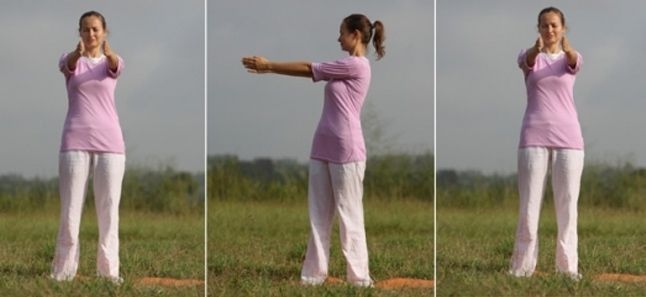
Stand straight and twist your spine from the torso towards your back; repeat this on both sides for a few sets and allow your upper body to release any tension.
2. Uttanasana (Forward Fold): This pose is an effective standing stretch that helps the whole body relax and rejuvenate. Start by standing straight, then slowly compress your core and bend down forward.

After dropping your whole upper body, feel the release of strain from your lower back and your upper body. This pose will also stretch the back of your legs, helping them become more flexible.
Vriksasana (Tree Pose) Variations to Consider
The following are some posture variations for your practice if you want to either make the Tree pose a little easier or a little more challenging:
1. Urdhva Hastasana (Palm Tree Pose): If you are unable to stand on one leg, try the palm Tree pose variation.
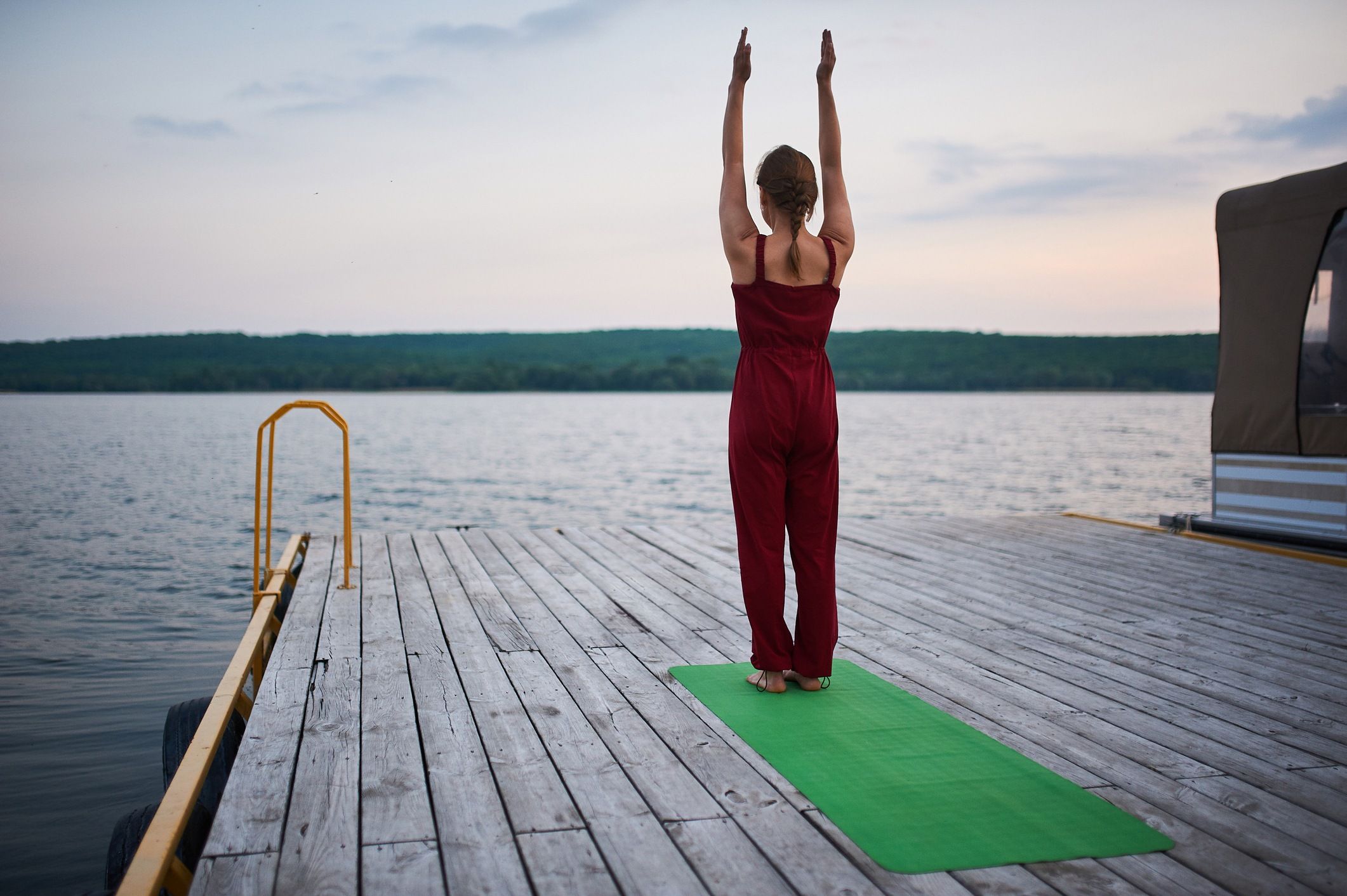
2. Ardha Padma Vriksasana (Half Lotus Tree Pose): If your lifted foot puts too much pressure on your knee joints, and you should avoid holding the pose for too long.

Try making a half-lotus formation with your foot and holding your leg in the air instead.
3. Vriksasana Variation (Tree Pose Side Bend): In order to increase the difficulty of a Tree pose, bend your torso from one side and flex your arms overhead in the side direction.
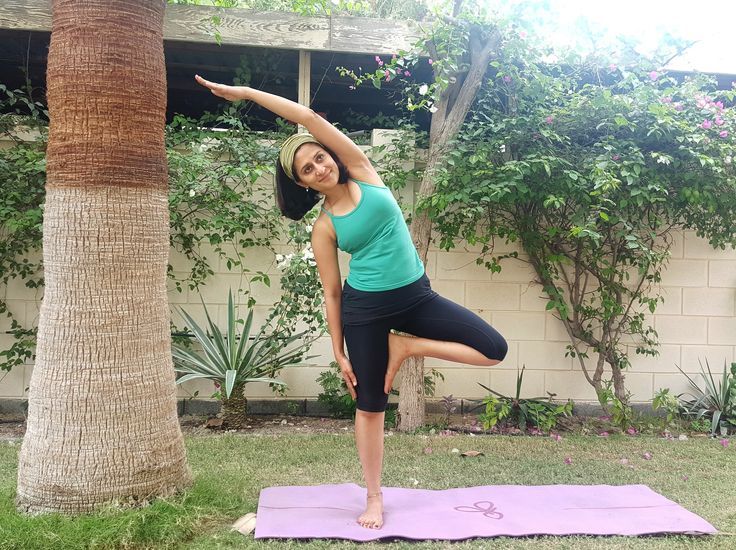
Hold this stretch for a few minutes, then release this side hinge pose and repeat the same on the other side.

Enjoy a Free 1-on-1 Session with a Coach!
Receive personalized guidance tailored to your unique fitness goals, live with a dedicated coach—no credit card required.
Frequently Asked Questions about Vriksasana (Tree Pose)
Vriksasana is a restorative yoga pose with various health benefits. It improves neuromuscular coordination, enhances mindfulness, reduces tension from the spine, and strengthens the core as well as leg muscles.
When a practitioner stands on one leg, it resembles a tree trunk, and when the hands are stretched out over the head, it symbolizes the tree's branches.
The name Vrikshasana is a Sanskrit word meaning Tree Pose. The word Vriksh means Tree, and Asana means Pose.
There are some big differences between Padmasana and Vrikshasana. First, Padmasana is a seated yoga pose, whereas Vrikshasana is a standing yoga pose. Second, the Lotus pose is done by crossing both legs together, whereas Vrikshasana is a half lotus pose formation with standing legs.
Yes, beginners can perform Vriksasana. It's an excellent pose for newbies to create a strong foundation for all standing balance yoga asanas. But, many beginners might find it challenging to balance on one leg. So, try to stand against a wall for assisted Tree pose variation, and eventually you can build the strength and balance necessary to hold the final Tree pose.



%20(7).jpg)
